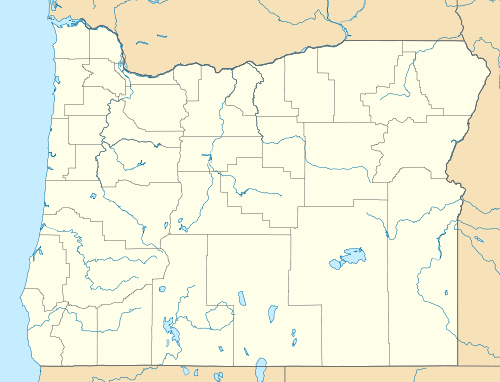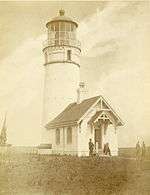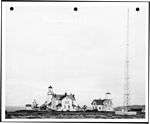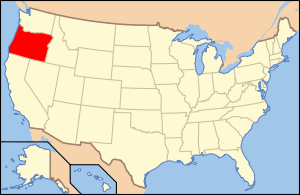Cape Blanco Light
 Cape Blanco Light | |
 | |
| Location | Oregon |
|---|---|
| Coordinates | 42°50′12″N 124°33′48″W / 42.83667°N 124.56333°WCoordinates: 42°50′12″N 124°33′48″W / 42.83667°N 124.56333°W[1] |
| Year first constructed | 1870 |
| Year first lit | December 20, 1870 |
| Automated | 1980 |
| Foundation | Brick |
| Construction | Brick |
| Tower shape | Conical attached to workroom |
| Markings / pattern | White tower, green lantern, red dome |
| Height | 59 feet (18 m) |
| Focal height | 256 feet (78 m) |
| Original lens | First order Fresnel (moved to Tongue Point in Astoria) |
| Current lens | Second order Fresnel (1936) |
| Range | 23 nautical miles (43 km; 26 mi) |
| Characteristic |
Flash White 20 Seconds |
|
Cape Blanco Lighthouse | |
| Nearest city | Sixes, Oregon |
| Area | 1.1 acres (0.45 ha) |
| MPS | Lighthouse Stations of Oregon MPS |
| NRHP Reference # | 73002339[2] |
| Added to NRHP | April 21, 1993 |
Cape Blanco Light is a lighthouse located on Cape Blanco, Oregon, United States in Cape Blanco State Park.
Construction of the light

In a deed recorded in 1867, John D. and Mary West sold the United States a 47.3-acre (19.1 ha) tract of land. The Light-House board determined that the offshore reef and islands at Cape Blanco were dangerous to maritime commerce; therefore, a lighthouse was authorized for construction.
Over the next three years, the lighthouse was constructed under the direction of Lt. Col. Robert Stockton Williamson. Supplies were ordered and shipped to the cape. Bricks were deemed cheaper if made onsite, so a brickmaker was located and a deal was struck with Rancher Patrick Hughes for access to the required materials.
Keepers
Many keepers followed Burnap, the most notable were James Langlois and James Hughes who served as keepers for 42 and 38 years respectively. James Langlois raised a large family. James Hughes, son of neighboring rancher Patrick Hughes, raised two girls.
For many years, Keeper Langlois requested additional housing for the station. With his large family, the Hughes family, and the other families that came and went, the duplex was just too crowded. His requests went unanswered until 1909 when Head Keepers' quarters were constructed.

James Hughes found his own solution before the government responded. James owned land across the Sixes River from his father and quickly constructed a home for his family, moving from the lighthouse about the same time they finished additional lighthouse quarters. James continued to work at the lighthouse, commuting to assume his duties.
Life was difficult on the cape, which experiences constant high winds during the spring and summer and severe storms in winter. The weather kept the keepers busy with continual repairs and painting. Despite the hardship, both Langlois and Hughes stayed there until retirement.
References
- ↑ "Cape Blanco Lighthouse". Geographic Names Information System. United States Geological Survey. February 15, 2011. Retrieved November 22, 2014.
- ↑ National Park Service (2010-07-09). "National Register Information System". National Register of Historic Places. National Park Service.
- Rowlett, Russ. "Lighthouses of the United States: Oregon". The Lighthouse Directory. University of North Carolina at Chapel Hill.
See also
External links
| Wikimedia Commons has media related to Cape Blanco Light. |
- Cape Blanco Lighthouse - Cape Blanco Heritage Society
- Lighthouse Keeper: Cape Blanco Light
- Oregon State Parks: Cape Blanco State Park


